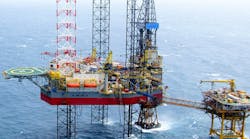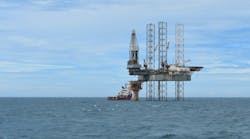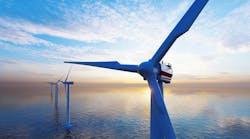Gene Kliewer • Houston
In addition to the offshore Iceland seismic available from Spectrum as described on the map (right), there is more arctic exploration news.TGS is acquiring 1,500 sq km (580 sq mi) of 3D multi-client seismic data between the Finnmark Platform and Nordkapp basin of the Barents Sea. TGS says the survey will follow the bended strike direction of the inverted margin between the two structures. The data will be processed by TGS and available to clients by 2Q 2012.Spectrum has released of 10,000 km (6,214 mi) of 2D multi-client seismic data over the Dreki/Jan Mayen Ridge offshore the northeastern Iceland. The datasets are within the acreage scheduled by the National Energy Authority of Iceland as part of the Second Licensing Round for hydrocarbon exploration and production. The application deadline is April 2, 2012. The Spectrum datasets have identified pre-Tertiary basalt sequences (possibly Mesozoic) and a number of seismic anomalies indicating hydrocarbons may be present. All the elements of a potential working hydrocarbon system have been identified within the area in both structural and stratigraphic play types. The inset map traces 1,702 km (1,058 mi) of regional tie lines that link the Jan Mayen through the Lofoten basin toward the Barents Sea margin and the proven petroleum system of the North Voering basin offshore Norway. The National Energy Authority of Iceland (NEA) has unveiled the second round for hydrocarbon exploration and production licenses on the Icelandic continental shelf.
The blocks are in the Dreki area northeast of Iceland, and cover 42,700 sq km (16,486 sq mi). Water depths are in the 800-2,000 m (2,625-6,562 ft). Dreki is part of the Jan Mayen ridge.
TGS, in partnership withPGS, also has a 22,000-km (13,670-mi) long multi-client survey offshore Labrador-Newfoundland. After suspending work on the program this fall, the vessel will return early next summer to complete the survey.
Further northeast, TGS started a 1,800-km (1,118-mi) 2D program offshore northeast Greenland. This is a joint TGS/Fugro project, with TGS processing the data.
In southeast Greenland, TGS acquired 29,000 km (18,019 mi) of airborne gravity, magnetic, and seep data during the third quarter of the year, the first time the company has deployed Seepfinder technology to detect oil seeps on the sea surface.
Another survey still under way is a 2D operation in the Laptev and East Siberian Sea of the Russian arctic, in partnership with Russian contractorDMNG. The vessel acquired 5,050 km (3,138 mi) of MC 2D during 3Q and early 4Q. Acquisition will continue into 4Q as long as ice conditions allow.
ION Geophysical acquired another 5,200 km (3,231 mi) of seismic offshore northeast Greenland. In addition, ION also worked in the 2011 Arctic Expedition at the Exclusive Economic Zone of the Russian Federation. The survey was performed by order of the Federal Subsoil Resources Management Agency, under the guidance of the State Research Navigation and Hydrographic Institute, in support of submission of Russia to the U.N. for extension of the limits of the continental shelf. Seismic data (approximately 6,000 km, or 3,728 mi) was acquired over 57 days, culminating in the acquisition of data at a distance of less than 300 km (186 mi) of the North Pole.
Reprocessing adds to prospects offshore Ireland
In climate contrast,Providence Resources says the Dragon discovery in the St. George's Channel basin off southeast Ireland may contain more gas than previously suspected. The new assessment resulted from a seismic inversion study over the area by IKON Geoscience. The study involved modeling of historic well and seismic data using more modern technology. The results suggest that the presence of the Dragon gas-bearing reservoir sands may be directly detectable from the 3D seismic data. Revised mapping using these inverted seismic data indicates that the gas accumulation may extend further into Irish waters than had been previously been mapped, with potential resources of up to 300 bcf. Providence has started additional reprocessing of the 3D seismic data ahead of a planned appraisal well in 2012.
Black Sea survey completed
Melrose Resources has started acquisition of a 3D seismic survey on the Galata exploration block in the Bulgarian sector of the Black Sea. Around 500 sq km (193 sq mi) of data will be acquired over the central part of the concession which contains the Chaika prospect, with estimated prospective resources of 80 bcf, and two other exploration leads.
The main focus of the Muridava acquisition program will be Eocene and Cretaceous leads and prospects in the same play as the existing Olimpiskiyi discovery and Lebada oil fields. 3D survey pending offshore Northwest Australia
TGS should be under way in acquiring new 3D multi-client seismic data over the Exmouth plateau in the Carnarvon basin offshore Northwest Australia. The acreage covers blocks WA-364-P, WA-365-P, and WA-367-P. Completion is expected in 1Q 2012 and a fasttrack data volume is to be available in 2Q 2012 with final data in 1Q 2013.
Elsewhere offshore Australia,Bengal Energy is designing a 750-sq-km (290-sq-mi) 3D program for late this year or early next in AC-P 47 off northern Australia. The area is 150 km (93 mi) west of the Vulcan graben production.
Bengal also is reprocessing available seismic data over its CY-OSN-2009/1 block offshore India. Additional seismic data may be collected between now and 1Q 2012 to accelerate the drilling of an exploration well.
3D program finished offshore Bahamas
Bahamas Petroleum says the 3D data acquisition phase of its seismic program offshore the Commonwealth of the Bahamas is complete. Acquired byCGGVeritas, the data is undergoing processing by the same supplier. A final total of 3,075 sq km (1,187 sq mi) was covered. The area was extended during the acquisition based on initial data quality. Bahamas Petroleum says the processing and interpretation of the 3D data will refine and reinforce the conclusions reached based on earlier 2D data and also will help define individual structures for further screening prior to drilling.
Offshore Articles Archives
View Oil and Gas Articles on PennEnergy.com






